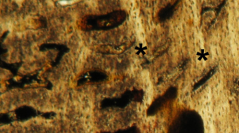

 Comptes Rendus Palevol
15 (1-2) - Pages 115-127
Comptes Rendus Palevol
15 (1-2) - Pages 115-127Ophiacodontids have long been considered the basalmost synapsids, and to have retained a fairly aquatic, piscivorous lifestyle typical of stem-amniotes. A restudy of their bone histology and microanatomy shows that Clepsydrops collettii , a Late Carboniferous ophiacodontid, has a thin, compact cortex and lacks a medullary spongiosa, two features that suggest a truly terrestrial lifestyle. The Early Permian Ophiacodon uniformis has a thicker cortex with a few resorption cavities and bone trabeculae surrounding the free medullary cavity. An inference model yields a terrestrial lifestyle for both taxa, though O. uniformis may have been slightly more aquatic (possibly amphibious) than C. collettii. However, an optimization of inferred lifestyle of other early stegocephalians (based on bone microanatomy) suggests that the first amniotes were terrestrial. The potentially amphibious lifestyle of O. uniformis, though not supported by our inference model, would thus be secondary. Histological features of femoral cortices in these two taxa closely resemble those previously described in extant species of large varanids and teids. This similarity, along with other comparative elements, is discussed in reference to the possible growth patterns and life history traits of Clepsydrops and O. uniformis.
Clepsydrops, Ophiacodon, Bone microanatomy, Bone histology, Lifestyle inference, Growth pattern, Paleobiology